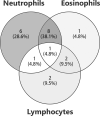Coexistence of Anti-p200 Pemphigoid and Psoriasis: A Systematic Review
- PMID: 35317170
- PMCID: PMC8934418
- DOI: 10.3389/fimmu.2022.839094
Coexistence of Anti-p200 Pemphigoid and Psoriasis: A Systematic Review
Abstract
Background: A close association between psoriasis and anti-p200 pemphigoid has been demonstrated by numerous studies. However, the clinical characteristics of patients suffering from these two entities have not yet been well-elucidated.
Objective: This study aimed to review the case reports and case series, summarizing clinical features and therapeutic strategies in patients suffering from anti-p200 pemphigoid and psoriasis.
Methods: A systematic review was conducted by searching PubMed, EMBASE, and Web of Science databases for studies published in English involving patients with psoriasis and anti-p200 pemphigoid on 6 September 2021. All case reports and case series reporting patients diagnosed with anti-p200 pemphigoid and psoriasis were included in this systematic review.
Results: A total of 21 eligible studies comprising 26 anti-p200 pemphigoid patients with preceding psoriasis were included in the qualitative synthesis. The average age at blisters eruption was 62.5 years, and the mean duration between the two entities was 15.6 years. Twenty-four percent of patients developed bullous lesions during UV therapy. Clinical manifestation of bullae and/or vesicles was recorded in all patients, and the trunk (94.7%) was most frequently involved, with only 15.8% reporting mucosal involvement. Epitope spreading was detected by immunoblotting in 33.3% of patients. All the patients reached completed remission during the course of disease, with 36.8% experiencing at least one relapse. Monotherapy of prednisolone was the leading therapeutic approach (n=6, 31.6%) required for disease control, but 5 (83.3%) of them suffered from blister recurrence after tapering or ceasing corticosteroid.
Conclusion: Most of the clinical aspects of patients with anti-p200 pemphigoid and psoriasis were similar to what was demonstrated in previous articles on anti-p200 pemphigoid. Nevertheless, compared with other anti-p200 pemphigoid cases without psoriasis, a clinical manifestation pattern with more frequent involvement of the trunk and less mucosal involvement was illustrated in those with psoriasis. Generally, monotherapy is sufficient for a complete remission for such patients. However, one or more relapses have been recorded in a considerable portion of patients, especially those prescribed with prednisolone. It reminded us to be more cautious during a tapering of medication.
Keywords: anti-laminin γ1 pemphigoid; anti-p200 pemphigoid; epitope spreading; psoriasis; systematic review.
Copyright © 2022 Xie, Wang, Li and Zuo.
Conflict of interest statement
The authors declare that the research was conducted in the absence of any commercial or financial relationships that could be construed as a potential conflict of interest.
Figures


Similar articles
-
Potential contribution of anti-p200 autoantibodies to mucosal lesions in anti-p200 pemphigoid.Front Immunol. 2023 Jan 25;14:1118846. doi: 10.3389/fimmu.2023.1118846. eCollection 2023. Front Immunol. 2023. PMID: 36761755 Free PMC article. Review.
-
Anti-p200 Pemphigoid: A Systematic Review.Front Immunol. 2019 Oct 22;10:2466. doi: 10.3389/fimmu.2019.02466. eCollection 2019. Front Immunol. 2019. PMID: 31695695 Free PMC article.
-
Clinical and immunoserological characteristics of anti-p200 pemphigoid: Comparisons of patients with epitope spreading and non-epitope spreading.Int J Dermatol. 2025 Feb;64(2):359-366. doi: 10.1111/ijd.17403. Epub 2024 Aug 19. Int J Dermatol. 2025. PMID: 39160661
-
Laboratory Diagnosis and Clinical Profile of Anti-p200 Pemphigoid.JAMA Dermatol. 2016 Aug 1;152(8):897-904. doi: 10.1001/jamadermatol.2016.1099. JAMA Dermatol. 2016. PMID: 27167149
-
A case of anti-laminin γ1 (p200) pemphigoid developed after dipeptidyl peptidase-4 inhibitor administration.J Dermatol. 2024 Jun;51(6):869-872. doi: 10.1111/1346-8138.17105. Epub 2024 Jan 12. J Dermatol. 2024. PMID: 38214494
Cited by
-
Case Report: Coexistence of bullous pemphigoid and psoriasis: Therapeutic challenge and IL17A-targeted parallel treatment strategy.Front Med (Lausanne). 2023 Apr 3;10:1148660. doi: 10.3389/fmed.2023.1148660. eCollection 2023. Front Med (Lausanne). 2023. PMID: 37077669 Free PMC article.
-
Case Report: Mucous Membrane Pemphigoid With IgG and IgA Anti-Laminin γ1 Antibodies and IgA Anti-Laminin α5 Antibodies.Front Immunol. 2022 Jun 1;13:903174. doi: 10.3389/fimmu.2022.903174. eCollection 2022. Front Immunol. 2022. PMID: 35720393 Free PMC article.
-
Potential contribution of anti-p200 autoantibodies to mucosal lesions in anti-p200 pemphigoid.Front Immunol. 2023 Jan 25;14:1118846. doi: 10.3389/fimmu.2023.1118846. eCollection 2023. Front Immunol. 2023. PMID: 36761755 Free PMC article. Review.
-
Understanding the Intricate Pathophysiology of Psoriasis and Related Skin Disorders.Int J Mol Sci. 2025 Jan 17;26(2):749. doi: 10.3390/ijms26020749. Int J Mol Sci. 2025. PMID: 39859462 Free PMC article. Review.
References
-
- Chen KR, Shimizu S, Miyakawa S, Ishiko A, Shimizu H, Hashimoto T. Coexistence of Psoriasis and an Unusual Igg-Mediated Subepidermal Bullous Dermatosis: Identification of a Novel 200-Kda Lower Lamina Lucida Target Antigen. Br J Dermatol (1996) 134(2):340–6. doi: 10.1111/j.1365-2133.1996.tb07625.x - DOI - PubMed
-
- Lau I, Goletz S, Holtsche MM, Zillikens D, Fechner K, Schmidt E. Anti-P200 Pemphigoid Is the Most Common Pemphigoid Disease With Serum Antibodies Against the Dermal Side by Indirect Immunofluorescence Microscopy on Human Salt-Split Skin. J Am Acad Dermatol (2019) 81(5):1195–7. doi: 10.1016/j.jaad.2019.03.077 - DOI - PubMed
Publication types
MeSH terms
Substances
LinkOut - more resources
Full Text Sources
Medical

